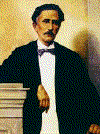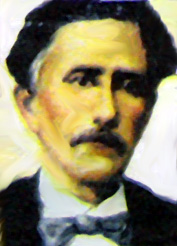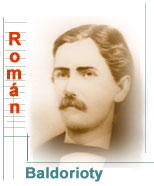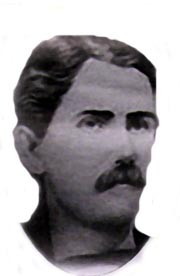Román Baldorioty de Castro
Román Baldorioty de Castro ( born February 23, 1822 in Guaynabo, Puerto Rico, † September 30, 1889 in Ponce, Puerto Rico) was the most famous abolitionist of the island and sat down on the right to self-determination of his homeland.
Life
Baldorioty came from a poor family. He received his education in the capital San Juan and was a pupil of Rafael Cordero. He studied with a scholarship in Spain and managed a degree in physics and mathematics at the University Complutense of Madrid. He also attended the Central School of Art in Paris. 1853 Baldorioty became a member of the Liberal Reform Party. In addition to politics, he was active in teaching. At the School of Commerce, Agriculture and Maritime Studies in San Juan, he taught botany and marine science.
From 1860 to 1865 he represented Puerto Rico as a member of the Spanish Parliament. He used his position to make known his views on the abolition of slavery and the establishment of a constitution that Puerto Ricans guarantees more political rights. In 1870 he was appointed representative of the Spanish court and gained there his reputation as the "father of the Puerto Rican autonomy". On November 19, 1872, he presented together with Luis Padial, Julio Vizcarrondo and the Spanish Minister of Overseas, Segismundo Moret, a draft for the abolition of slavery. On March 22, 1873, the Spanish government approved the proposal, which became known as the Moret Law.
Upon his return to Puerto Rico in Ponce founded in 1873 Baldorioty the newspaper El Derecho ( The Act ). He also founded the weekly newspaper La Crónica, in which he could preach his ideas of the island autonomy. In 1887 he became the president, founded together with José de Diego Autonomist Party of Puerto Rico and appointed the young politician Antonio Rafael Barceló as Secretary. Your party was one of the first ever in Puerto Rico. After her credo Puerto Rico should form its own government and have a representative in the Spanish parliament. The Spanish government considered Baldorioty as a dangerous person and dissidents, so they imprisoned him in the Fort San Felipe del Morro in San Juan. Although he was quickly released from prison, his health suffered greatly from the short imprisonment and he died shortly thereafter.
In Bayamón, Juana Díaz and San Germán plazas are named after him. In addition, several schools and a highway bearing his name in Puerto Rico.









